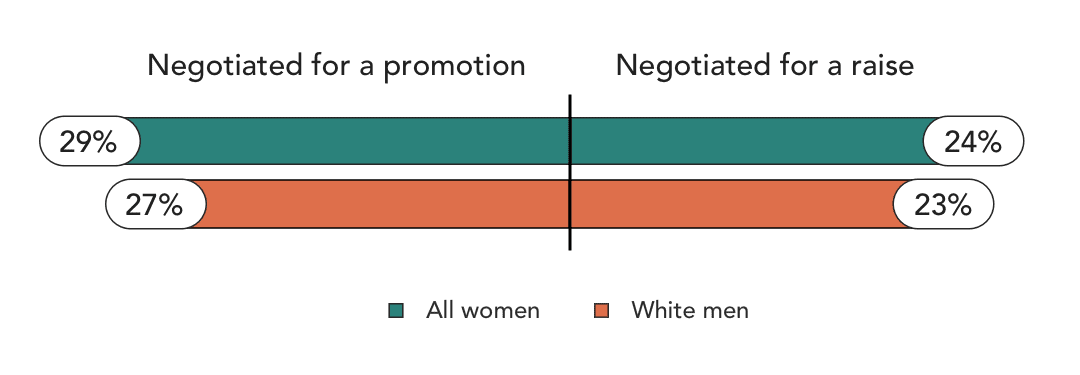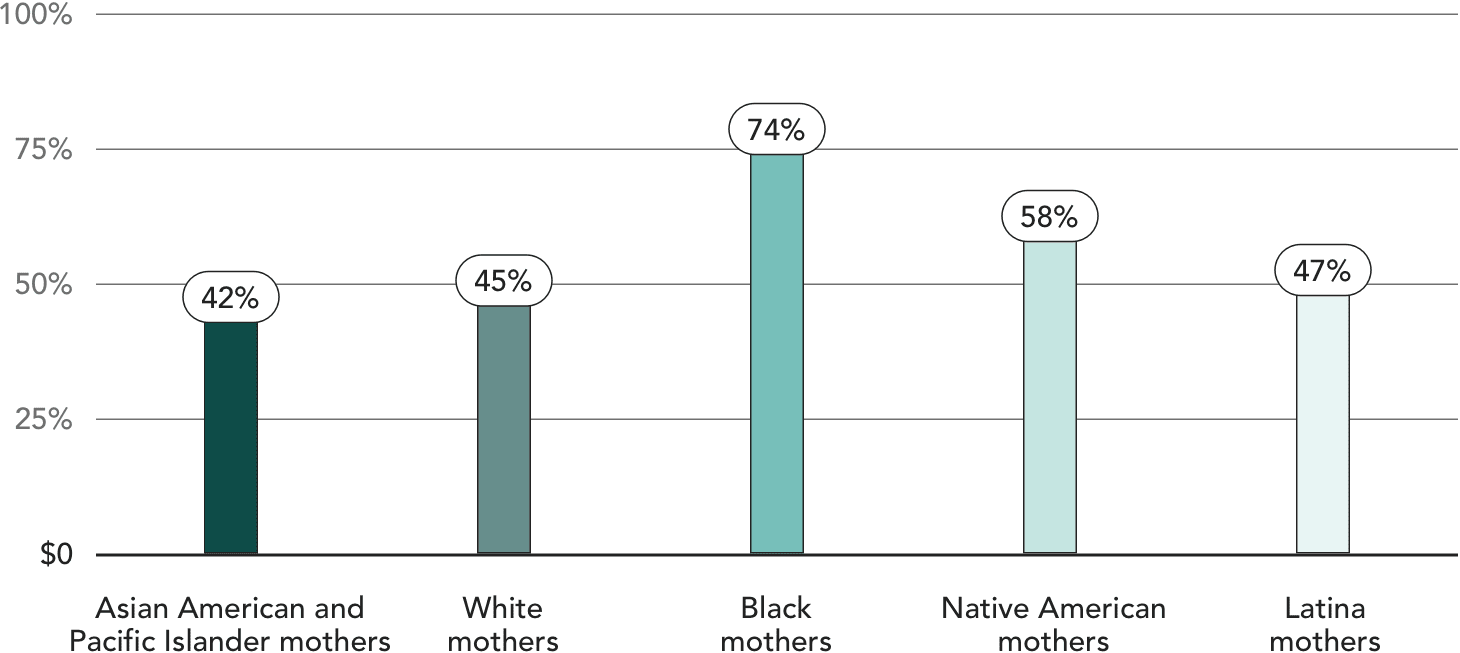Women are paid less than men—and the gap is closing too slowly
Get the facts about the gender pay gap.
What you need to know
Women are paid less than men
When you look at full-time, year-round workers, women in the U.S. earn just 84 cents for every $1 earned by men. But that’s only part of the story. Among all workers—including the millions who worked part-time or for part of the year —the gender pay gap widens to 78 cents for all earners.1

How it works
Women are asking for more—they’re just not getting it
Women are asking for promotions and negotiating for raises at the same rates as men—and we’ve seen this in our research since 2015.10

Why it matters
Women are losing out on millions
The pay gap is not about a single paycheck. Over the course of a career, the lost income can add up to over a million dollars.
Average lost income over a 40-year career due to the pay gap11

Did you know?
The pay gap widens the wealth gap: in other words, how much women are worth, or how much they own. Single white women own 92 cents on the dollar compared to single men. And shockingly, single Black women own less than 8 cents on the dollar compared to white men.12
Families are on the front line
Mothers are breadwinners in half of U.S. households—meaning their families depend on their paycheck. When moms are paid less, they have less money for basic family necessities like rent, groceries, and school supplies. Over time, this impacts families’ ability to invest in savings, higher education, or property.
Share of mothers who are breadwinners13

Did you know?
The pay gap is even worse for mothers—who are paid on average 63 cents for every dollar fathers make. This inequality holds true across race, state, and occupation. 14 This inequality holds true across race, state, and occupation.
Closing the gap benefits everyone
Closing the pay gap isn’t just a win for women—it has social and economic benefits too. If women were paid fairly, we could cut the poverty rate in half and inject over $500 billion into the U.S. economy.15
Every woman deserves fair pay.
It’s time to close the gap.
Other Resources
Footnotes
- Anwesha Majumder, National Partnership for Women and Families, personal communication, February 2024. The data for women of different races and ethnicities is calculated including women who worked part time or part of the year. The number for all women is based only on women who worked all year long, all year round. When you include workers who worked part-time or part of the year, you get numbers that are more inclusive and accurate because many of the same reasons that lead to the wage gap also lead to women being more likely to work part-time or for part of the year.
- Data visualization shows median weekly earnings across race and ethnicity for every dollar white men earn. From Hegewisch and Mefferd, “Lost Jobs, Stalled Progress.” Note: For Native American women, data used is from the National Women’s Law Center, “Native American Women Need Action That Closes the Wage Gap” (September 2021), https://nwlc.org/wp-content/uploads/2020/09/Native-Women-Equal-Pay-2021.pdf
- Jessica Mason, National Partnership for Women and Families, personal communication, September 2022
- U.S. Department of Education, National Center for Education Statistics, “Degrees conferred by postsecondary institutions, by level of degree and sex of student: Selected years, 1869–70 through 2029–30” (2020), accessed March 8, 2021, https://nces.ed.gov/programs/digest/d20/tables/dt20_318.10.asp?current.asp.
- Note: Pay gaps by education level increase in absolute dollar amounts.
- U.S. Census Bureau, “Current Population Survey: Wage and Salary Workers—People 25 years and older by Median Usual Weekly Earnings, Education Level, Race, Hispanic Origin, and Sex,” accessed March 3, 2023, https://data.bls.gov/PDQWeb/le.
- Sarah Javid, National Women’s Law Center, “Native Women Lose More Than $1.1 Million to the Racist and Sexist Wage Gap Over a 40-Year Career,” Novemeber 2023, National Women’s Law Center (September 2019) https://nwlc.org/wp-content/uploads/2022/11/NWEPD-2023.pdf.
- Miller, “As Women Take Over.”
- Ibid.
- LeanIn.Org and McKinsey & Company, Women in the Workplace 2019 (October 2019), https://womenintheworkplace.com.
-
National Women’s Law Center (NWLC), “The Lifetime Wage Gap by State for Women Overall” (March 2024), https://nwlc.org/resource/the-lifetime-wage-gap-by-state-for-women-overall/.
NWLC, “Lifetime Wage Gap Losses for White, Non-Hispanic Women State Rankings” (March 2024), https://nwlc.org/resource/the-lifetime-wage-gap-by-state-for-white-non-hispanic-women/
Losses for Black Women State Rankings” (March 2024), https://nwlc.org/resource/the-lifetime-wage-gap-by-state-for-black-women/
Native American Women Overall State Rankings” (March 2024) https://nwlc.org/resource/the-lifetime-wage-gap-by-state-for-native-women/
NWLC, “The Lifetime Wage Gap by State for Latinas” (March 2024) https://nwlc.org/resource/the-lifetime-wage-gap-by-state-for-latinas/
NWLC, “The Lifetime Wage Gap by State for Asian Women” (March 2024)https://nwlc.org/resource/the-lifetime-the-lifetime-wage-gap-by-state-for-asian-women/
NWLC, “The Lifetime Wage Gap for Native Hawaiian and Other Pacific Islander Women” (March 2024) https://nwlc.org/resource/the-lifetime-wage-gap-by-state-for-nhopi-women/ - Daan Struyven, Gizelle George-Joseph, and Daniel Milo, “Black Womenomics: Investing in the Underinvested,” Goldman Sachs, The Bigger Picture (March 9, 2021), https://www.goldmansachs.com/insights/pages/black-womenomics-f/black-womenomics-report.pdf.
- Julie Anderson, “Breadwinner Mothers by Race/Ethnicity and State”, IWPR #Q079, April 2020, Accessed February 16, 2022, https://iwpr.org/wp-content/uploads/2020/05/QF-Breadwinner-Mothers-by-Race-FINAL-46.pdf. Note: Breadwinner mothers are defined as single mothers who head a household or partnered mothers who generate at least 40 percent of a household’s joint income.
- Anwesha Majumder, National Partnership for Women and Families, personal communication, February 2024. The data used to calculate the gap for mothers are from IPUMS (https://usa.ipums.org/usa/sda/) using the 1-year ACS data from 2022. Within the data, NPWF looked at the median of the income earned variable (incearn) by sex with these filters: incearn(1-999998) nchild(1-9) yngch(0-17) age(16-140) (i.e. the sample is limited to people 16+ with positive income/earnings and at least one child under the age of 18).
- Jessica Milli et al., “The Impact of Equal Pay on Poverty and the Economy,” IWPR #C455 (April 5, 2017), https://iwpr.org/wp-content/uploads/2020/09/C455.pdf.







